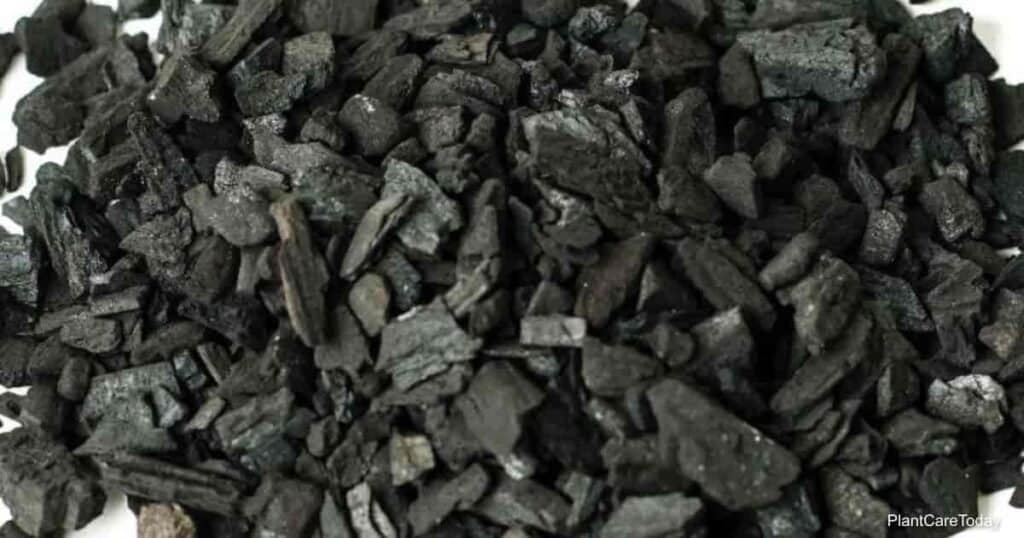Activated charcoal can be an excellent addition to your houseplant soil.
If you put a layer of this inexpensive substance in the bottom of your planter or mix it into the soil, it will help eliminate impurities in the soil.

Additionally, it prevents odors and mold and helps keep insect pests away.
Activated charcoal works in this way because it has very fine pores and ample inner surface area where a wide variety of substances can adhere.
What Is Activated Charcoal?
Activated charcoal is carbon that has been exposed to extremely high temperatures.
This process activates the substance by causing it to develop a very porous texture, creating the ample surface area mentioned above.
Other benefits imparted by activated charcoal include:
- Reduced chance of fungal and bacterial infections
- Better air circulation
- Reduced soil acidity
- Improved drainage
- Greater porosity
- Stronger roots
Activated charcoal is also widely used in plant propagation methods, such as:
- Synthetic seed production
- Orchid seed germination
- Somatic embryogenesis
- Micropropagation
- Protoplast culture
- Stem elongation
- Bulb formation
- Anther culture
- Rooting
It is also used to improve the development and growth of cells in tissue culture.
It is believed that the positive effect activated charcoal has in all of these uses is because a wide variety of inhibitory compounds gather upon and stick to its surfaces (adsorption).
This simply takes these horticultural ne’er do wells out of action so that they cannot interfere with plants’ health and well-being.
Additionally, activated charcoal adsorbs individual atoms, ions, and molecules of brown exudates, phenolic exudates, and toxic metabolites.
The substance may also adsorb excess nutrients and plant growth regulators and then release these substances in small quantities that promote and stimulate plant growth. [source]
Activated Charcoal Was A Key Component Of The NASA Clean Air Study
It is also worth noting that the addition of activated charcoal to the soil was an essential component in NASA’s clean air plant study.
While many “clean air plant” proponents focus on the ability of the plants to remove toxins from the air, the fact is, the clean air plant study found that the roots and soil of houseplants, along with a specially designed activated carbon filter, actually provided most of the air purifying benefits.
The greenery of the plants had little to do with this phenomenon. [source]
Can You Use Activated Charcoal In Your Garden?
You can use activated charcoal to help your garden plants by following these 10 simple steps:
1. Determine the area of your planting site by measuring length and width and then multiplying these two numbers to get the square footage. You’ll need a pound of activated charcoal for every two square feet of garden.
2. Purchase the right amount of activated charcoal. Be sure to get natural horticultural charcoal. Don’t attempt to use broken-up briquettes or some such. This will not work!
3. Be sure your garden soil is neither soggy nor dusty. It should be moist enough to form a ball when you pick up a handful of it and squeeze it.
4. Remove surface debris until your garden is 8″ or 10″ inches deep.
5. Sift through the soil and remove rocks, sticks, and other detritus.
6. Spread activated charcoal over the entire surface of the soil at a rate of half a pound per square foot.
7. Top the charcoal with aged manure if you wish.
8. Add granulated fertilizer if you wish.
9. Water your garden plot thoroughly to help your soil absorb your amendments (charcoal, manure, and fertilizer).
10. Allow the soil to settle and the water soak in for a couple of days before planting.
Although you will need to amend your soil with manure and fertilizer each year in the springtime, you needn’t repeat the charcoal application annually.
It will remain active and effective in your soil for many years.
This is why it is a good idea to apply a layer of activated charcoal to the surface of your garden soil, along with soil amendments such as manure and fertilizer.
The charcoal will absorb the nutrients and gradually release them, promoting steady, vigorous plant growth.
